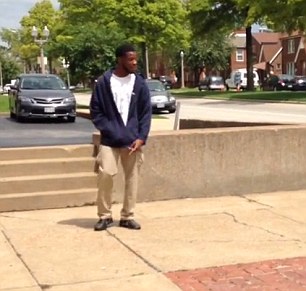
Kajieme Powell shooting coverup

By MiamiDadeFLA
If you treat the Kajieme Powell shooting as a police overreaction and subsequent cover-up to a mentally ill person consider whether you are part of the cover-up. The conditions that the protestors in Missouri are protesting are historic, institutional, economic, and deep seeded. It is entirely possible that someone would be willing to die to protest these injustices, both real and perceived without being mentally ill, even while people are quick to label someone willing to die as mentally ill. Before the police arrive Powell knows what to expect. He says “Get the fuck away from me. I’m on Instagram, I’m on Facebook.” He knows he’s being filmed and he knows that it will make front page news.
The cops arrive.
He approaches them wearing a heavy sweatshirt, alternately with his hands in his pockets and out and states repeatedly his desire to be shot. “Shoot me now motherfucker.” The police tell him to get his hands up and get his hands out of his pockets and a man from the crowd tell him to drop his weapon (a knife), “drop [the weapon] it bro,” But Powell’s intent on challenging the police to actually shoot him. And they do. Commenters speculate that Powell’s desire was to move himself out of the line of fire as he meanders on his approach with death to avoid the loss of innocent life in the crowd. This coincides with his warning as he waits on the sidewalk for people filming him to “Get the fuck away from me.”
In the media coverage broadcast on the front page of Huffington Post we see a warning that the content is graphic, a warning repeated on YouTube, but the substance of the story is the video itself, with the journalism reduced to the narrative of inadequate police training and excessive force used by the police, including the number of bullets that were fired into Powell and discrepancies about the words on the police report and in press reports and what can be observed on the video, such as whether the measured distance of Powell from the police as they opened fire was really 3-4 feet. This is the focus rather than a focus on larger injustices, both real and perceived that Powell would presumably be protesting.
Contrast the desire of the family of the reporter James Foley not to show or watch the footage of their son taken hostage by a group calling itself the Islamic State of Iraq and Syria and the media’s respecting of this wish with both Powell’s willingness to die and knowledge that this shooting might be a catalyst for change in what for many people consider to be unsustainable conditions and the media’s unhesitatingly publishing the unedited video footage of the Powell shooting.
The Huffington Post ran with the headline – SHOCK VIDEO: STL COPS GUN DOWN MAN.
Ryan Grim writes: “Here’s the police explanation of the #Powell shooting, next to actual video of the shooting. You decide:”challenging readers and viewers of the video to decide for ourselves, while the media discourages viewers from watching the video of the reporter killed by ISIS in the belief that it only serves to further ISIS’s propaganda ends, including their demand that President Obama cease bombing their group in Iraq.
The camera-man who witnessed the police handcuffing a man they had presumably killed, was upset by this indifference to the man’s life at the perceived need for officer safety. But the reaction to this story should be about more than just what the police report says or how many bullets were fired or whether officer’s safety concerns were justified or “legal”, but about systematically correcting real injustices that lead men to be willing to die to bring attention to them. To honor the courage of men like Foley in risking his life and dying to report the whole story demands that we report the whole story, too, even if we don’t have to watch the gruesome videos of a man dying.